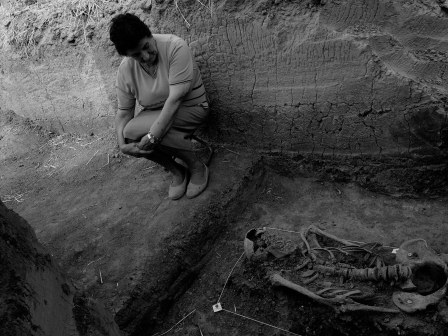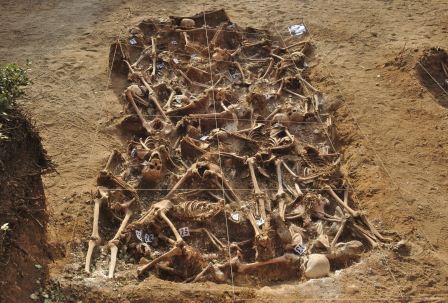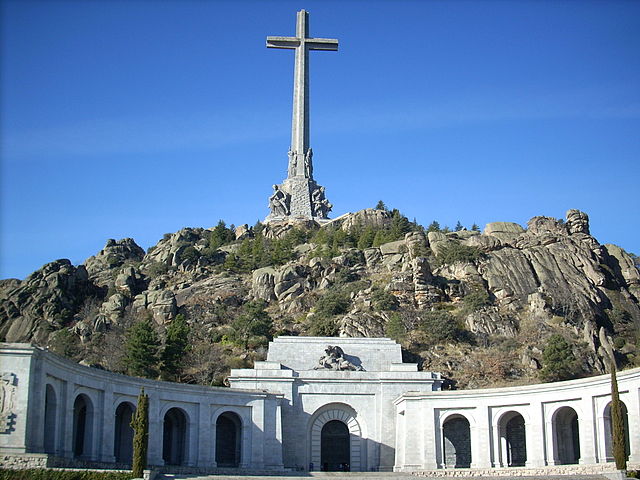An Underground Landscape of Terror
Cultural anthropologist Francisco Ferrándiz has spent the last 13 years of his life studying the impact of Civil War exhumations in Spain, working in close collaboration with groups like the Association for the Recovery of Historical Memory. Thanks to their efforts, Spanish citizens have exhumed more than 6,000 bodies since 2000—most of them civilian victims shot by Francoist troops.
“I’m exhausted. The work has been fascinating, but let me tell you: thinking about death all the time, day in day out—that’s tough.” I speak with Ferrándiz on a wintry Sunday afternoon in Círculo de Bellas Artes, one of Madrid’s iconic cafés. As the country’s political landscape is shifting under our feet, Ferrándiz looks back on the road traveled so far.
“Over the years we’ve had to manage very difficult situations. An exhumation of a mass grave generates a lot of problems and family tensions. While a death in any family causes suffering, people generally have resources and rituals—even if they are not religious—to process a death by accident or illness. But the appearance of a dead body from 70 years ago, bullet-ridden, finished off with a shot in the head, with all the added political pressure—that’s not something many families are prepared for. We have helped to establish protocols that have eased some of that tension. Still, there have been plenty of complications: marriages between descendants of victims and victimizers, right-wing relatives who refuse to acknowledge that grandpa was an anarchist, and so on.
The appearance of a bullet-ridden body from 70 years ago, that’s not something many families are prepared for.
“We are part of a team of experts that includes forensics and archeologists. But while our partners work in the grave itself, as anthropologists we move around, talking to the people. We deal with very complicated circumstances, trying to put things in perspective. I think our academic analyses have helped everyone involved with the exhumations to gain a richer understanding of the process. Conversely, we have also learned a lot from the victims, our team partners, like the great forensic scientist Francisco Etxeberria, and from people like Emilio Silva. Back in 2002, when we were just starting out, we honestly had very little idea of what all this was about. Nor could we have imagined the scale it would take.”
Hasn’t attention for the historical memory of the Civil War waned since the economic crisis of 2008?
FF: It’s true that there is less media attention for exhumations than there was. But that’s normal. Memory is cyclical. And truth be told, in Spain we’ve had something of an overexposure. Images of bodies and bones were all over the newspapers, television, and social media, to the point of saturation. Still, the fact that the mass graves were so prominently present in the media for a decade is extraordinary. The image of the Civil War grave has established itself firmly in Spain’s optical unconscious. By now anyone can conjure up a picture of an exhumation.
The recent drop in media attention is actually not a bad thing. Anyone who has studied trauma can tell you that you can’t be permanently agonizing over the same thing. It’s not healthy. And as a result, the ongoing exhumations take place in an environment that’s much more tranquil. These things are tense enough without the presence of five television cameras and 18 journalists. For the people involved, being out of the spotlight is probably much better.
***

Berlangas de Roa (Burgos), 2004. Exhumation of the remains of five inhabitants of Haza (Burgos) who were detained and assassinated in August 1936, among them the mayor of the town. The mayor’s daughter sits beside her father’s remains. Photo Clemente Bernad. From Desvelados.
During a brief six-year period, between 2006 and 2012, the Spanish government subsidized some of the exhumation efforts. When Spain’s conservative Partido Popular returned to power in 2012, it refused to honor the Law of Historical Memory passed five years earlier. Since then, government funding has been zero. But exhumations have been continuing on a shoestring, with volunteer labor and private donations. “Thanks to the ALBA-Puffin Award, the Association’s technical team can work for another two years,” Ferrándiz says. “They are highly experienced, and there is a waitlist of people who have requested their assistance to find loved ones. We have continued our research as well. One of our people, for example, is now looking at the long-term effects of exhumations on small-town communities, 10 years later.”
Some writers have argued recently that the focus on historical memory is a distraction: that while Spain was obsessed with excavators digging up bones, the country failed to notice the political corruption that inflated the real estate bubble which burst in 2008. The novelist Javier Cercas claimed that historical memory became an industry of its own.
FF: Cercas is full of it. Is there a memory industry in Spain? Sure. And is there one in Argentina? Also. And the same is true everywhere else in the world. That’s simply the way capitalism works. Ironically, Cercas himself has sold millions of books about the Civil War, in dozens of languages. No, the real scandal is not the memory industry. It’s the way the Spanish state chose to handle the financing of exhumations starting in 2006. Not only did the government outsource work that it should have taken responsibility for, but its allocation of subsidies was irresponsible and opaque. They never consulted with us or with other experts. Nor was there proper oversight of the projects that were financed. It was a disaster.
Francisco Ferrándiz
Paco Ferrándiz is one of the world’s leading experts in the anthropology of exhumations. Since 2007 he has worked at the national research council in Madrid (CSIC), where he leads an interdisciplinary team of 16 scholars. After earning his Ph.D from UC Berkeley, he worked in the Netherlands, Mexico, and the Basque Country. Last year he published The Buried Past (El pasado bajo tierra), an extensive reflection of his work in Spain, along with a widely-read English-language essay on the topic in American Ethnologist.
He is now branching out into comparative work. With Tony Robben he has co-edited Necropolitics: Mass Graves and Exhumation in the Age of Human Rights, which has just been published by the University of Pennsylvania, and which gathers a series of case studies from around the world. “It’s the first book to appear in the United States that deals with the anthropology of exhumations,” he says. “It will open up a whole new field of study.”
You work in an interdisciplinary team. What specifically can cultural anthropology contribute to our understanding of the ways a country like Spain comes to terms with its past?
FF: One of our most important contributions to the public debate, I think, has been to historicize the graves. The graves we are exhuming now are the left-overs: these are the bodies of civilian victims on the Republican side, largely murdered in the rearguard. There were plenty of exhumations right after the war, when the Franco regime took care of its own. Tons of bodies were moved in those years. In the early 1960s, another 30,000 bodies were transferred to the Valley of the Fallen from all over the country. It was a chaotic operation. There’s a lot we don’t know yet about those episodes. But we suspect that more than a few bodies have no relation to the Civil War at all, and that some of them are executed Republicans who ended in the Valley without their family’s knowledge.
Your work seems to confirm two points: that the process of exhumations is absolutely necessary for a country like Spain to be able to move forward, and that we can only really understand this process in a global context. You wrote recently: “the Spanish case shows that societies eventually need to confront head-on the most disquieting elements of the past”, and you add that “sweeping such history under the rug” has long-term negative effects on societies.
FF: Yes. The mass graves are an underground landscape of terror, sown to politically paralyze the Spanish population. To dismantle that landscape is an absolute necessity. We cannot allow “progress”—the construction of business parks or airports, for example—to just bulldoze the graves.
The mass graves are an underground landscape of terror, sown to politically paralyze the Spanish population.
Yet some established historians in Spain reject the legitimacy of the historical memory movement and the notion that the Spanish situation can be understood through other countries, like Chile and Argentina. Why is that?
FF: Honestly, I don’t get the historians who hold these views. As an anthropologist, I tell them: my work begins where yours stops. You believe that the significant pieces are the facts you describe in your books. That’s fair enough. Yet for me, the most interesting part is the next phase: the ways societies process those facts.
Still, I can think of two explanations for these historians’ reactions. One is professional: they are simply incapable of understanding the depth of the phenomenon of the exhumations. To them, the whole thing seems gratuitous, a necrophilic whim. “I already talked about those victims in my book,” some of them say; “we have already published those lists of victims.” What they don’t realize is that they have obviously not been able to transfer that knowledge to the rest of society in a significant manner.
The second explanation is biographical. If you are someone who’s had a hand in the design of the transition to democracy, who’s believed in it, supported it, seen its benefits; if you are a full professor, and suddenly these nobodies appear out of nowhere, people who don’t even hold an academic post, and they tell you that it’s all been useless—well, then you are forced to rethink your own biography. And that meets with resistance. Which is why they clamp up and say: “You’re all just obsessed with those bodies and bones.”
And how about the international context? Some have argued that reading Spain through the lens of, say, Chile or Argentina, is a big mistake, that to speak of the Spanish victims as “disappeared” creates a false analogy.
FF: It’s complicated, and took me a while to figure things out. But I’ve concluded that it does make sense to think of the Spanish victims as disappeared, although they are a different kind of disappeared than those of Chile and Argentina.
When Judge Baltasar Garzón issued his famous writ in October 2008, in which he spoke of 114,266 Spanish disappeared, I thought he was insane. For one, where the hell did he get that number? It’s based on lists drawn up by local and national associations, but there’s lots of confusion there, no unified protocol and no double-checking. There was no agreed pattern as to who “counted” as executed, for example. Others were not counted at all.
Garzón spoke of 114,266 Spanish disappeared. Where the hell did he get that number?

Mass grave in Estépar, Burgos provinde, with 25 Republican victims, exhumed in July-August 2014. Photo Mario Modesto Mata. CC BY-SA 4.0
Still, I believe the term “disappeared” is the correct one, despite what critics like Javier Pradera have said. The term doesn’t just turn up in the Spanish context through a simple act of copying. Its route is more complicated. It starts in Chile and Argentina, yes. But then the term is taken up by the Inter-American Court, which establishes a Convention in 1994 that labels forced disappearance as a crime against humanity. Later, the UN’s General Assembly approved the International Convention for the Protection of All People from Forced Disappearances in New York in 2006. That Convention has been ratified by a large number of countries. From that point on, any country in the world can anchor its historical experience in that universal concept.
In Spain, the change was huge. Think about it: when we laid eyes on the first mass graves, what we saw were victims of executions. When we look at a grave now, we see victims of forced disappearance. In legal anthropology we talk about the “social lives” of rights: the ways a right enters the public’s imagination, or social space, independent of its judicial routes. In that sense, in Spain the notion of forced disappearance has really struck a chord. It’s a crime against humanity that has no statute of limitations and continues to be committed every day until the disappeared person is found.
When we laid eyes on the first mass graves, we saw were victims of executions. Now we see victims of forced disappearance.
Now, are the Spanish victims really desaparecidos in this sense? At first I wasn’t so sure. For a while I spoke of quasi-disappeared. But I’ve changed my mind. The truth is that many Spanish families don’t know, or only vaguely know, what happened to their loved ones, and where they might be buried. We don’t know the identity of many of the exhumed corpses. Isn’t that a pattern of forced disappearance, too? Of course it is, without a doubt.
***

Frontal view of the Valle de los Caídos and Santa Cruz basílica. El Escorial, Madrid, Spain. Photo Pablo Forcén Soler. Public domain
You talk about an underground landscape of terror. But there are also plenty of structures above ground. I’m thinking about the massively monumental Valley of the Fallen, the mausoleum for Spanish Civil War victims constructed over 20 years’ time by political prisoners, where almost nothing has changed since Franco inaugurated it in 1959, except for the fact that Franco himself was buried there. In 2011 you were a member of a specially appointed commission charged with rethinking the Valley.
FF: Yes, the Valle de los Caídos. There are few places in the world that amass such an amount of sheer terror and surrealism. In the commission we came up with very interesting ideas, including a non-religious memorial with an educational component. When the Partido Popular came to power the report was tossed into a drawer. But my research team has also made it available online.
You can open up doors toward the future but you cannot sweep the past under the rug.
We thought it was essential to dismantle the monument’s funeral hierarchy, which is still profoundly Francoist. What do you see in the middle of the main nave? The tombs of Franco and José Antonio Primo de Rivera, the founder of Spanish fascism who was executed in jail in 1936. Well, you can’t democratize the monument while respecting that hierarchy. So we figured we’d start with a red line in the sand, separating those who died in the war from those who did not. Did Franco die in the war? No. So, out with him! Just like that, you break the Franco-José Antonio tandem. Next, you can’t have José Antonio, the martyr of Francoist martyrs, right there in the middle. So we proposed moving his body to the lateral crypts, behind the walls with the 30,000 others. We presumed, of course, that his family would never accept that, and rather remove him from the Valley altogether. All the better, good riddance.
Without Franco and José Antonio there, the central nave would have totally changed. But then we came up with a third ploy. The Valley is now marked as a religious cemetery, consecrated by the Benedictine Monks who occupy the monastery there, and who bless it in their daily mass. Now what would happen if you turned it into a secular cemetery? Then it would pass from the Church’s care into that of the state. But in that case, the Benedictines’ blessings would simply bounce off the walls. Instead of saying mass over 33,841 bodies, they’d say mass over exactly zero bodies!
Working through the Civil War and Francoism, it seems, is not a process that is going to end any time soon—if it can ever truly end.
FF: No, it doesn’t end. But there are milestones. If we manage to drastically rethink the Valley of the Fallen, for example, we would have crossed a new frontier. Still, even that has to be a democratic process. You can’t have some guy come in and impose a monument. The only way to build consensus is through Parliament and public debate, in which different voices have to be heard and balanced. And from an anthropological point of view, the process does not stop once the monument is there. It always continues.
What you cannot have, however, is false closure. You can open up doors toward the future but you cannot sweep the past under the rug, as happened for so long with the mass graves. This is why I have my doubts about transitional justice. Truth commissions can work, but they can also impose a false sense of closure. It all depends. You can’t predict their symbolic effect. A huge truth commission might have a minimal impact on society, while a small gesture can be enormously efficient. That’s something not even the experts can predict.
Sebastiaan Faber chaired ALBA’s Board of Governors from 2010 until 2015. He teaches at Oberlin College.














